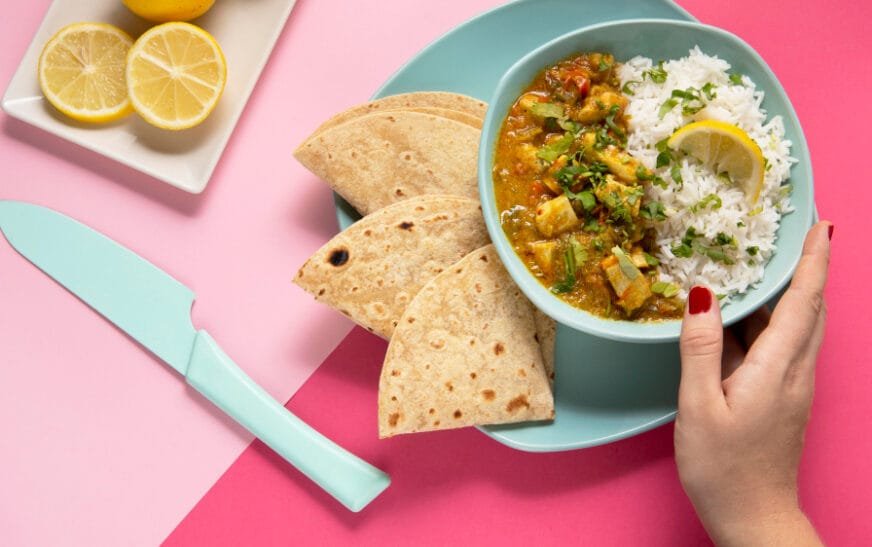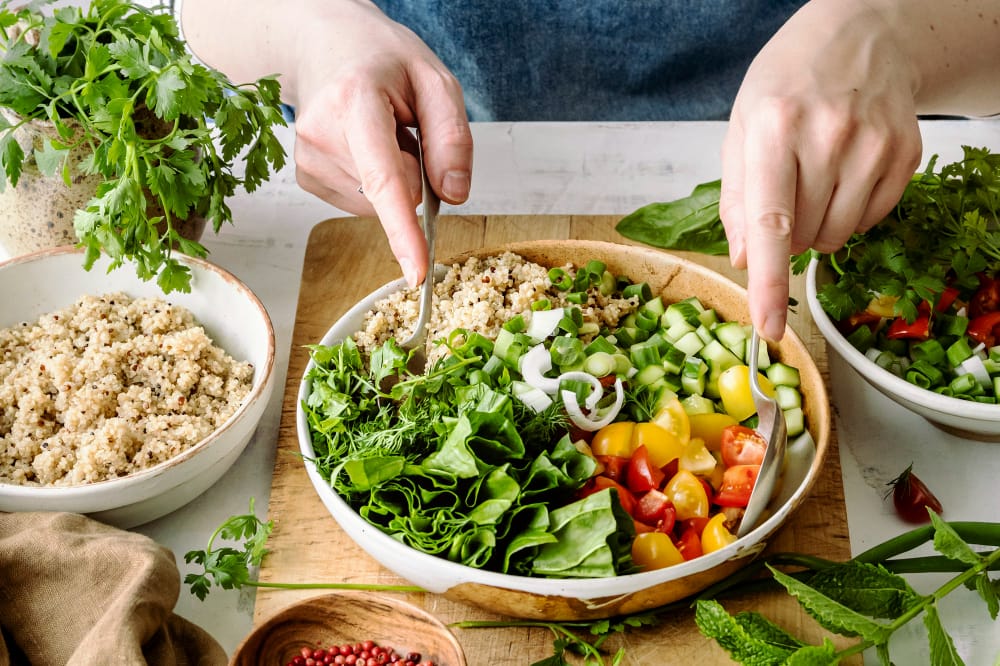Plain roti, which is a visible part of many South Asian food regimes, is now becoming popular worldwide, including in the USA, because of its ease of preparation and healthiness. But that does not necessarily mean you have to sacrifice taste to get extra nutritional value. Here are some simple methods of preparing this basic flatbread. Whether you are a fitness freak out, a working person, or someone who prefers having healthy food, by following the above four smart strategies, you will add one more value to the roti.
So in this one, we will be focusing on ways by which you can transform your roti, adding nutritional value, ease of digestion, and contemporary sizing it a little. Now let’s focus on how to empower your Roti while keeping it tasty. As famed Indian food blogger Anuja Madar states, ‘Roti is not just an accompaniment; it is the main act’.
1. Using Whole wheat or Multigrain flour instead of the normal bright white refined flour.
First and foremost, those who wish to make their roti healthier should consider using whole wheat or multigrain flour instead of refined white flour (maida). White flour has reduced fiber, vitamins, and mineral content because these attributes are extracted during refining, while with whole wheat flour, you get the whole package.
Benefits of Whole Wheat Roti:
- Rich in Fiber: Whole wheat includes the outer layer of the grain, which is the bran, and the inner, also called the germ, both of which are rich in fiber. It also promotes good digestion, prevents or lowers flatulence or bloating, and helps to control the body’s blood sugar levels while, at the same time, slowing the rate of hunger pangs.
- Vitamins & Minerals: It is a good source of iron, magnesium, and B-group vitamins, which are important for body activities.
- Lower Glycemic Index (GI): The GI of whole wheat roti is lower than that of refined flour; to be more precise, it has a slow glycaemic index effect, thus making it suitable for diabetic patients or anybody who wants to check his/her blood sugar.
- Multigrain Flour Options: If you desire even healthier bread, one more suggestion is to use multigrain flour, which can be composed of grains such as barley, millet, oats, and sorghum or jowar. All these grains have different nutrient profiles, which makes your roti a complete food in its own right.
- Barley: Source of fiber, good for the heart, and is effective in cholesterol control.
- Oats: Charged with beta-glucan, a fibre that gets rid of cholesterol and strengthens the immune system.
- Millet (Bajra/Ragi): These vegetables are rich in calcium, iron, and antioxidants, making them an excellent food for pH balances in the bones.
- Sorghum (Jowar): Nutrient-dense, containing gluten-free, protein, fiber, and antioxidant properties.
How to Make It Work: Begin with whole wheat flour at 70% and multigrain flour at 30%, and then adjust to what you fancy. These grains’ addition allows every portion of roti to contain a complete range of the body’s required nutrients.
2. Add Protein-Rich Ingredients
Protein is an essential macronutrient that is usually missing in a vegetarian’s diet. The best and most efficient approach to incorporate the protein into the roti is through incorporating substances with protein content into the dough.
- Chickpea Flour (Besan) or Soy Flour: Besan or chickpea flour is not only a good source of protein, fiber, and vitamins such as Vitamin B’ and iron. Soy flour, as opposed to soybean, is a protein product since it contains all nine essential amino acids.
- Chickpea Flour: requires additional protein, increases fiber, and imparts a nutty taste.
- Soy Flour: A good source providing high-quality protein and is ideal for those who do not take meat or any animal product.
Other Protein Additives:
- Flaxseeds: Flaxseeds are another excellent addition to the aviary diet because flaxseed contains both omega-3 fatty acids and protein and has a subtle nutty taste. You can also take ground flaxseeds and add them to your flour to increase the nutritive value.
- Quinoa Flour: Quinoa is another plant-based complete protein that sorts the amino acid profile of your roti in addition. Besides, it is still without gluten and contains magnesium and iron.
How to Make It Work: These protein-rich flours should be blended with your wheat or multigrain flour at a proportion of 20–30 percent. For instance, you can substitute whole wheat flour with 80 percent and chickpea or soy flour with 20 percent. It also does the same for the pizza sauce, as it improves the taste while increasing the overall protein of the pizza without having a tremendous impact on texture.
3. The Two Superfoods and Seeds
Good examples of these are chia seeds, flaxseed, and spinach powder that, when added to your roti, will give the roti a nutritional boost. Superfoods have nutrients with antioxidant properties and vitamins, and these healthy fats have benefits to the heart, such as enhancing digestion and building the immune system.
Chia Seeds and Flaxseeds:
- Chia Seeds: These tiny seeds are ideal ingredients when considering foods that provide fiber, protein, omega-3 fatty acids, and calcium. They are known to fight inflammation as well as promote good bone health.
- Flaxseeds: A popular ingredient that is praised for its ability to reduce cholesterol levels and facilitate digestion, flaxseeds are incredibly rich in omega-3s and lignans (antioxidants of plant origin).
- Vegetable Powders (Spinach, Beetroot, Moringa): Next time you prepare your roti dough, you can add a small portion of vegetable powder that contains vitamins and minerals. For example, spinach powder contains iron and vitamins A and C; beetroot powder contains folate and manganese; and moringa powder contains calcium and antioxidants.
How to Make It Work: All that is needed is approximately 1-2 tbsp of chia seeds, flaxseeds, or vegetable powders added to the flour. This small provision puts the softness of the roti and the caloric density at their highest number possible.
4. Healthy Oils & Ghee
The adulteration of ‘healthy oils and ghee’ should be done with extra care and intelligence while selecting the oils and ghee for the food-fortifying process to be undertaken. The following kinds of oils ought to be used throughout the food fortification process.
Most people would not consider incorporating fat into their diet in particular, but it is rather good for you and your health. Fats are necessary for the transportation of fat-soluble essentials (A, D, E, and K vitamins), brain food, and slow-burning fuel.
- Use Cold-Pressed Oils: Replace your oils with cold-pressed oils such as olive oil, avocado oil, or coconut oil. Compared to refined oils, these oils retain a lot of nutrients and offer healthy fats in essential amounts, like omega-3 and omega-9 fats.
- Olive Oil: Olive oil contains monounsaturated fats that are beneficial for the heart as well as containing antioxidants.
- Coconut Oil: Full of medium-chain triglycerides (MCTs), coconut oil increases energy and metabolism.
- Ghee (Clarified Butter): Clarified butter, or ghee, has been an accompaniment of Indian kitchens for hundreds of years and is valued for its taste and health-promoting properties. CLA: conjugated linoleic acid that has the potential to take care of body fat and butyrate—a short-chain fatty acid that is good for the gut. Although ghee is made up of saturated fat, it is a type of fat better digested than many other types of saturated fats.
How to Make it Work: Rather than using butter or margarine to knead your roti dough, use ghee or a healthy cooking oil; one tablespoon would be enough. This not only brings an improved taste but also makes sure that your body can assimilate some important nutrients effectively. These oils should, however, be taken in moderation so as not to balance our fat intake in our diets.
Bonus Tip: Go Gluten-Free
For the gluten-intolerant or those on a low-celiac diet, you can prepare roti using gluten-free flour. Widespread types of flour that are gluten-free include almond flour, rice flour, and buckwheat flour. These flours, which are used in diets, also come along with their own nutrient package.
- Almond Flour: High in healthy fats, protein, and vitamin E.
- Rice Flour: I use rice flour in my baking recipes since it is light contains no gluten and is therefore easy to digest.
- Buckwheat Flour: That is why it is very rich in fiber and proteins and is perfect if you want to get rid of gluten.
CONCLUSION
Sometimes, adding nutrients to roti does not have to be a big change. Just adding whole grains, using protein sources, adding some superfoods, and enriching with healthy oils can bring about a massive nutritional enhancement of the daily bread. No matter where you are—in the USA or in any other part of the world—you can try the following tips to make the roti less sinful and much healthier in the process.
Not only will these small changes help you achieve better health, but they will also help you get more satisfying and better balanced meals. Therefore, the next time you prepare roti, consider these smart strategies to boost roti nutrition value, yet keep the flavors and texture in mind.













